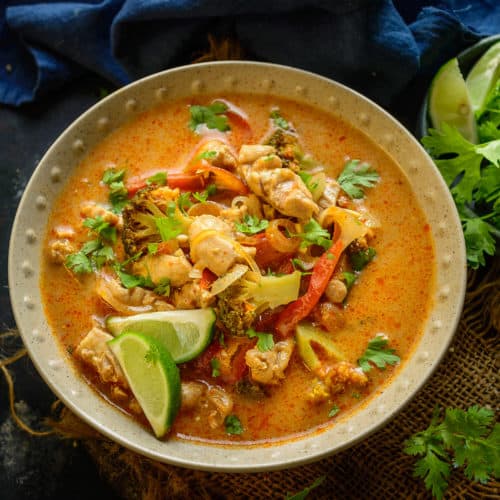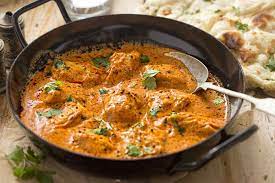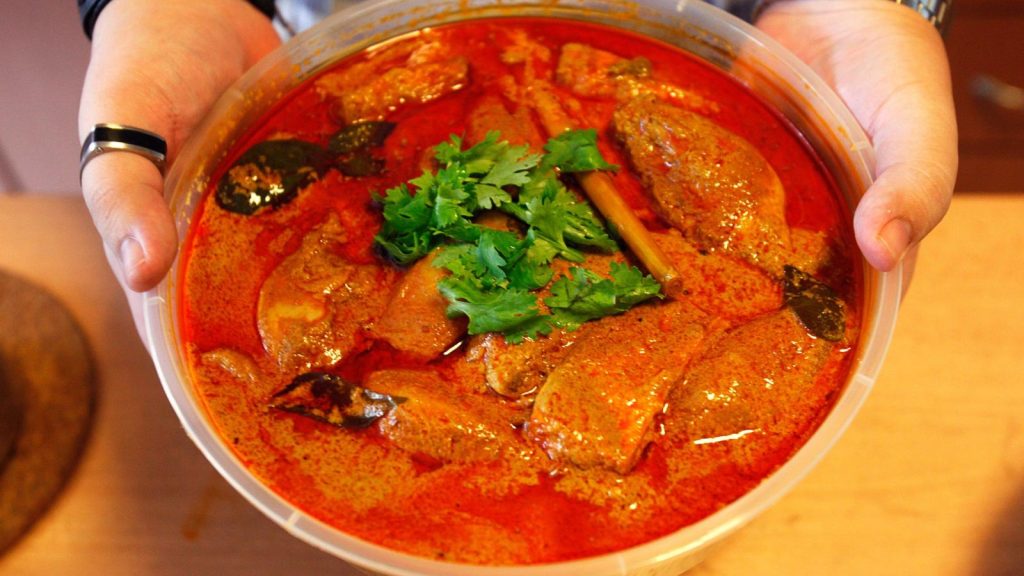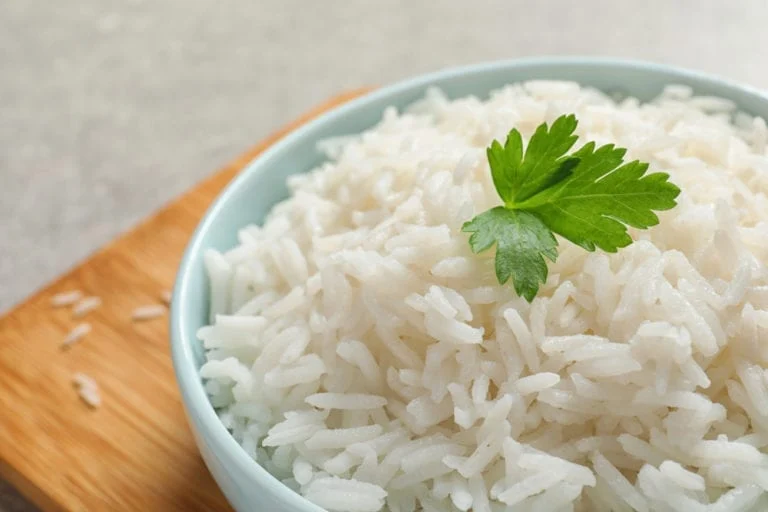9 Differences between Indian and Thai curry

I enjoy practically all types of food, but Indian and Thai cuisines are two of my favorites. I’m relatively familiar with the differences between the two cuisines, but I thought I’d refresh my memory and look more into the differences between Indian and Thai curry.
Here’s what I found out:
In general, Indian and Thai curries differ in the following ways:
- Cumin and coriander are common ingredients in Indian curry but not in Thai curry.
- Curry leaves can also be used to cook Indian curry.
- Fresh chili peppers and herbs are used in Thai curry, whereas dry spices are used in Indian.
- Indian curry may contain cream, although Thai curry is typically dairy-free.
- Thai curry is made with a thick sauce from various curry pastes combined with coconut milk and cooked meat and veggies.
But there’s a lot more to these incredible meals than that, so keep reading.
What exactly is curry?

The term curry was coined by the Tamil people of India and Sri Lanka to designate a variety of meat and vegetable meals prepared with a spice rub mixture rather than a sauce.
When producing the spice rub, one of the cornerstones of Indian curry is curry plant leaves.
Surprisingly, the curry plant leaves are absent from most US spice blends labeled curry powder (which we get into below). Ironically, much of what we think of Indian food in the United States is primarily entrenched in Great Britain.
In fact, England formerly occupied India, and many individuals of Indian heritage now reside in the UK. Curry powder and even Chicken Tikka Masala are, therefore, popular even in England.
The term “curry” extended over much of Asia over time, with several Asian countries, including Thailand, adopting it.
Curry is traditionally cooked with red, yellow, or green curry paste in Thai cuisine (there are other variations, such as panang). To make a sauce, the paste is combined with coconut milk.
Is there a distinction between Thai and Indian curries?
There is a significant difference between Thai and Indian curry; the only thing they have in common is the name. Dried spices are used to make an Indian curry, which is frequently served with cream and tomato. Fresh chili peppers are pounded into a paste and combined with coconut milk and fish sauce to make Thai curry.
The earliest curry, Indian curry, employs a mixture of Indian spices as a rub on meat and vegetables. While the meat and vegetables are cooked with tomatoes, they aren’t too sauced.
On the other hand, Thai curry is created with various curry pastes made from fresh ingredients and has a thick, moist consistency, unlike spice mixes.
To make a rich sauce, the curry paste is combined with coconut milk.
The spiciness is determined in part by the amount of curry paste used, which is usually only a few teaspoons for a large pot of curry.
What they have in common are a depth of taste and intriguing spices.
Apart from the heat, turmeric for color and a fondness for fresh cilantro leaves as a garnish, Indian and Thai curry are practically indistinguishable.
Let’s take a look at each one individually.
What is Thai curry, exactly?

Thai curry is commonly divided into a few categories, such as:
- a shade of green (the hottest)
- The color yellow (the mildest)
- The color red (in the middle)
- Panang (similar to red but with a little tang from shrimp paste)
- Massaman is a term used to describe a person (milder and sweeter, often containing peanuts)
- All Thai curries were initially made with the same ingredients: ginger, garlic, lemongrass, galangal (Thai ginger), and chili peppers.
The usage of chilies is one of the critical ways Thai curries differ from one another.
Green chiles are used extensively in green curry, which is generally the strongest, and red curry employs red chiles to give it a somewhat gentler spiciness and a characteristic crimson color.
On the other hand, yellow Thai curry uses a lot of turmeric to give it that signature yellow hue and uses fewer chili peppers than other Thai curries, making it the mildest of all Thai curries.
What exactly is an Indian curry?

Curry powder in a jar dates back to the occupation of India by the British.
In India, curry refers to a spice blend. However, each meal would use distinct spices rather than a single blend for all dishes.
The spices used in Indian curry vary greatly, not only in the United States but also in India. Each location and locale in India may have its preferences for which Indian culinary spices to utilize.
The following are some of the most frequent Indian culinary spices included in curry powder:
- Coriander is used in the powder form (made from dried cilantro seeds)
- Cumin
- Turmeric
- Chili powder with cayenne
- Fenugreek, asafoetida (hing), cardamom, and other Indian culinary spices are also common. Contrary to popular belief, spices such as cinnamon and ginger powder are not typically used in curry.
Cinnamon (together with clove) is a critical ingredient in garam masala powder, frequently used at the end of cooking.
Ginger is a common component in Indian cuisine, but it is usually used fresh rather than powdered.
Why aren’t the leaves of the curry plant included in most curry powders?
Curry powder does not usually contain curry plant leaves since when they are dried, they lose their exquisite and distinct flavor. On the other hand, curry powder is rarely used in England, and it is an Indian creation that has become popular in the United States.
Curry leaves are an integral component of Indian cuisine, particularly in South Indian cuisine. They give anything they’re cooked into a mild but perceptible and palatable flavor.
While they are edible after cooking, most people toss them aside like a bay leaf after eating.
Fresh curry leaves are frequently available in Indian markets, and I once purchased a live curry plant. As previously said, dried curry leaves will not add much flavor to your dish.
Is Thai curry similar to Indian curry?

Thai curry has no resemblance to Indian curry. Thai curry is usually hotter and tangier than Indian curry, but it has a lighter consistency. Indian curry, like Thai curry, can be spicy, but it’s usually creamier and uses a lot of dried spices like turmeric, cumin, and coriander to produce the flavor profile.
While some ingredients (ginger, garlic, turmeric, chili peppers, and cilantro) are shared between the two cuisines, they are vastly different.
While both Indian and Thai cuisines can be spicy (and made gentler or spicier), I have always preferred Thai cuisine.
Thai curry likewise uses a lot of coconut milk, whereas Indian curry is far less saucy and more on the spices. When Indian food gets saucy, it uses a lot of ghee (clarified butter) and cream in various dishes, whereas Thai food does not utilize dairy products.
Indian cuisine extensively uses the cilantro plant’s dried and ground leaves (also known as coriander), while Thai cuisine favors fresh cilantro leaves.
In the end, they all have the same curry name, but do some tasting and decide for yourself.
Which Thai curry is the best?
Because “best” is such a subjective term, you’ll almost certainly get ten different replies if you ask ten individuals this question.
Green curry, however, always appears to be the most popular in my experience of eating at Thai restaurants and selling Thai items at Whole Foods Market. By far, the least popular are yellow, panang, and massaman.
On the other hand, Panang is my favorite since it has a lovely tang from the shrimp paste. Although it is hot, the heat does not overshadow the flavor, as is sometimes the case with green curry.
But I’ve never had a curry I didn’t like, so give them all a try!
What is the mildest Thai curry?

Remember that because all Thai curries begin with curry paste, you may easily adjust the heat level by adding or subtracting curry paste.
Coconut milk is added after the first paste has been sautéed in some oil with possibly diced onion and garlic.
Green and red curries, on the other hand, receive their distinct colors from chili peppers. It is because turmeric gives yellow curry its color, comparatively it is usually the mildest.
What is the spiciest Thai curry?
In this case, the color green comes out on top.
So, if you like spicy food, Thai green curry is for you. Green curry gets its color and heat from fresh, immature green chilies.
On the vine, almost all chiles start green, which is when they are the hottest.
They often turn various hues of yellow, orange, and red as they age on the vine.
Red bell peppers, for example, cost more than green bell peppers because they are required to stay on the vine longer.
When grapes are left on the vine for extended periods of time, the farmer receives a lower yield over a year than if they are picked more often. Red peppers are more expensive since they are plucked (and then re-grown) less frequently.
The longer they sit on the vine, the milder they become (though don’t expect a mild ghost pepper from a vine-aged ghost pepper).
What are the most common spices used in Indian cuisine?
The beauty of Indian cuisine is that, while there are a few essential spices, Indian cooks don’t just use cumin, turmeric, ginger, and coriander powder in everything.
Each meal has its unique spice combination, making each dish stand out from the others. While not every spice is used in every dish, the following are the most commonly used spices in Indian cuisine:
- Turmeric
- Coriander
- Cumin
- Fenugreek
- Asafoetida plant (hing)
- Mustard seed with cardamom
- Saffron
- Garam masala (itself a mixture of cinnamon, clove, coriander, cardamom and cumin)
While ginger is pretty frequent in Indian (and Thai) cuisine, Indian cuisine rarely utilizes ginger powder and instead employs freshly grated ginger.
What’s the difference between garam masala and Madras curry?
Cinnamon, clove, coriander, cardamom, and cumin are used to make garam masala. Madras curry is an Indian innovation that refers to a curry powder or sauce made with chili peppers, tamarind, and yogurt (Madras is the former name of the city of Chennai). When the dishes have been done cooking, garam masala is added.
In India, garam masala is widely used.
The meal is often mellowed (a little) with the addition of yogurt after it is created with a lot of chili powder. Tamarind, which has a raisin-like sweetness, is commonly used in Madras curry, giving it a sweet and sour flavor.
However, garam masala and Madras curry are two completely different things.
How is Indian curry different from Jamaican curry?
Allspice, which has a licorice-like flavor, and thyme are used in Jamaican curry and chili peppers. Cumin, coriander, turmeric, and occasionally chili peppers or paprika are used in Indian curry, giving it a distinct flavor profile from Jamaican curry.
Unlike Indian curry powder, which is an Indian innovation rarely seen in Britain, Jamaican curry is a popular dish in the Caribbean.
However, because Great Britain occupied Jamaica at one point, the flavors could have been introduced to Britain at that time as well.
In Indian cooking, allspice and especially thyme are rarely, if ever, utilized. Because Jamaican curry uses fresh chili peppers instead of chili powder, Jamaican curry powder isn’t particularly spicy.
Turmeric powder, coriander, cumin, and fenugreek are all used extensively in both dishes.
So, let’s have a look at the…
9 Surprising Dissimilarities Between curry from India and curry from Thailand:
Garlic, onion, cumin, and fresh cilantro leaves are used in both Indian and Thai curries. They are, however, very different and only share a name.
1. Thai curry has an intense coconut milk base, whereas Indian curry virtually never does.
In Thai cuisine, coconut milk is a must-have component, and there is no coconut milk in Indian curry. In India, however, “curry” is all about the spice mixture.
While coconut milk is occasionally used in Indian cuisine, cream or yogurt are more regularly used to thicken sauces. Tomato sauces that are rich and spicy are also prominent in Indian cuisine.
2. Curry powder in a jar is not utilized in Thai cuisine.
There is perhaps no better place for Indian food outside of India than the United Kingdom. In reality, chicken tikka masala, a popular Indian dish, is so popular in Scotland that they believe they invented it (but only as a joke).
The British occupation of India from 1858 to soon after World War II and the fact that a considerable number of Indian families have relocated to the UK over the decades are the reasons for the UK’s expertise in Indian food.
Thus, curry powder, which can be found on the shelves of every grocery shop in the United States and the United Kingdom, is not used in Thai curry.
3. Thai curries begin with curry paste, which is made from fresh ingredients rather than dry spices.
While Indian curry paste is available like curry powder mixes, it is more likely to be a British innovation than a native Indian staple.
On the other hand, Thai curries always begin with curry paste, a mashed mixture of fresh vegetables and herbs like garlic, onion, lemongrass, Galangal, and chili peppers.
Other than salt and pepper, Thai cuisine does not traditionally use dried herbs and spices (and even then gets much of its sodium from the fish sauce, which has a saltiness similar to soy sauce).
4. While fresh cilantro leaves are frequently adorned in Thai curry, the dried seed of the cilantro plant, known as coriander, is nearly never used in Thai cuisine.
Coriander powder is widely used in Indian cuisine.
Contrary to popular belief, it is frequently used in double the amount of cumin or turmeric. Coriander seeds are the dried seeds of the cilantro plant; however, unlike cilantro leaves, coriander seeds have a sweet, lemony flavor.
Thai cuisine does not employ coriander; however, fresh cilantro leaves are frequently decorated in Indian and Thai cuisine.
5. Ghee (clarified butter) is used in almost all Indian recipes, and many have heavy cream or yogurt-based sauces. Thai cuisine, on the other hand, rarely uses dairy products.
Ghee is butter that has been gently boiled and allowed to solidify again after any solids or impurities have been skimmed away.
Ghee is an Indian creation that is used to sauté nearly everything in Indian cuisine. Cream and yogurt are often used in Indian cuisine to make creamy sauces.
Thai sauces frequently feature coconut milk, but they may also include chicken broth and fish sauce, which are not commonly seen in Indian cuisine.
6. Basmati rice is served with almost all Indian dishes, whereas Jasmine rice is served with almost all Thai dishes.

Both Indian and Thai cuisines enjoy serving rice to accompany their meals.
Basmati rice, a bowl of aromatic, long-grain rice that smells vaguely like popcorn when cooked, is the traditional rice in India and Pakistan. Hindu traders introduced it to other Middle Eastern countries, and it is now widely used in Arab countries as well.
On the other hand, Jasmine rice is a long-grain rice that has a floral flavor, and it also loses flavor more quickly, so look for vacuum-sealed jasmine rice.
Thailand and Cambodia consume a lot of jasmine rice.
7. Curry leaves are not utilized in Thai food, though they are commonly stir fried and brought to a boil with cooked lentils in traditional Indian curries.
Curry leaves are ultimately responsible for the concept of curry.
Curry leaves are rarely used in canned curry powders because they don’t have much flavor when dried (a UK invention anyway). Curry leaves are cooked in Indian cuisine before being tossed out like a bay leaf.
Thai cuisine does not use curry leaves at all.
8. While ginger is used in Thai and Indian cuisines, Thai ginger, also known as Galangal, has a distinct flavor.
Under the rhizomes family of root vegetables, galangal and ginger are related. On the other hand, galangal has a rootsy and lemony flavor and is significantly more robust in flavor, despite its similar appearance.
Galangal cannot be grated. However, it can be readily cut or diced. Don’t use regular ginger if you want to make Thai food properly.
9. In Thai cuisine, rice noodles are frequently substituted for rice, whereas Indian cuisine is never served with any noodles.
Everyone’s favorite Thai dish is Pad Thai, but Pad Thai isn’t complete without rice noodles, right?
Rice noodles, whether thin like angel hair or larger and flatter like fettuccine, are classics in Thai cuisine, though jasmine rice is also famous.
On the other hand, India does not utilize pasta and relies only on rice as a starchy side dish, whether plain steamed basmati rice, pulao, or biryani, which are more like rice pilaf or stir-fried rice.
Have we answered all of your questions about the differences between Indian and Thai curry?
We take a deep dive into the world of Indian and Thai cuisine, notably curries, in this piece.
We looked at the history of curry, the most common Indian culinary spices used in Indian curry, and the differences between Indian and Thai curry.
Indian curry and Thai curry are entirely dissimilar and have nothing in common in terms of flavor, and each has unique characteristics that set them apart. In the end, the only actual resemblance is the name.











